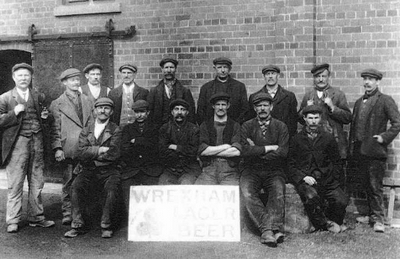The UK has a storied love affair with beer, with brewing traditions that stretch back thousands of years. From the discovery of hops in the Anglo-Saxon Graveney Boat of 900 AD to evidence of ancient ales brewed over 2,000 years ago, Britain’s brewing history is as rich as its ales.
Over the centuries, abbey monks, alewives and pioneering brewers have left their mark on the craft, and today, some of the UK’s most iconic beer brands still honour these traditions. Here, we explore the ten oldest beer brands and breweries in the UK:
Shephard Neame, Faversham, Kent – 1698 (or 1570)
Though Shepherd Neame’s official history began in 1698 with Richard Marsh’s purchase and establishment of the brewery, records show that its roots in brewing go back to at least 1570, when John Castlock owned and operated the import and export of beer out of 18 Court Street, where brewing has continued ever since. Now Britain’s largest (and, of course, oldest) independent family brewer, Shepherd Neame is anything but old-fashioned. They own over 300 pubs and hotels in the UK and brew 225,000 barrels each year. Their diverse portfolio continues to rack up some of the industry’s most prestigious awards and accolades, including the Royal Warrant on their classic ale Spitfire.
Fuller’s, Chiswick, London – 1845 (or 1581)
Fuller’s, which is known to have begun brewing in 1845, given its immortalisation in one of their famous ales, also has a history dating back to the 1600s. It was the case of a property used for brewing being passed down and down again only to be saved by an investment from John Fuller, John Smith, and John Turner; hence how Fuller, Smith & Turner came to fruition. This investment in 1845 skyrocketed the brewer into notoriety, with Chiswick Bitter arriving in 1930 and eventually London Pride taking centre stage and maintaining that position into the present day.
Three Tuns, Bishop’s Castle, Shropshire – 1642
In Shropshire sits a miniature Victorian tower turned brewery delivering ales which capture the essence of English brewing in a “living museum”. The yeast used is a one-of-a-kind strain which has been developing for over 125 years and has resulted in an award-winning ale with heritage at its heart.
Samuel Smith Old Brewery, Tadcaster, North Yorkshire – 1758
Samuel Smith Old Brewery in Tadcaster has been using stone Yorkshire squares made of solid blocks of slate to ferment nearly all its ales and stouts alongside the same yeast strain which has been used since the 1800s. They do so in a brewery established in 1758. The historic and traditional process results in a full-bodied and rich-tasting beer, true to the taste it may have had 100s of years ago. The only difference is that the brewery now has a network of small, local pubs operating from Edinburgh to Cardiff and Carlisle to London. A truly independent establishment, the pubs are only stocked with Samuel Smith beers, with hand-painted signs and no TVs or radios. For local deliveries, the town relies on the Shire horses five days a week. Samuel Smith, unlike many remaining breweries, welcomes the old-fashionedness at every level, from production to consumption.
Theakston, Masham, North Yorkshire – 1827
Operating out of Masham, North Yorkshire for nearly 200 years is Theakston. The independent family brewing company founded in 1827 has been controlled and run by direct descendants of founder Robert Theakston since its establishment. The best of its production portfolio is Theakston Old Peculiar, which is now sold in many countries overseas and is admired as an iconic beer internationally and at home, thus contributing to the “craft beer revival”.
Young’s, London – 1831
In 1831, Charles Allen Young hit the ground running with the purchase of a brewery and 82 pubs in London. Since then, Young’s Brewery has been an independent family business with over 288 establishments across the UK. Despite their growing monopoly in the pub industry, their intentionality shines in their unique pub signs, each carefully designed to showcase the pub’s significance. Like The Beaufort, located 200 yards from the RAF museum and named after the type 152 Beaufort aircraft.
Marston’s, Burton-on-Trent – 1834
In Burton-upon-Trent, there are 12 breweries, 104 pubs, and over 5,000 people employed in the beer and pub sector. Largely considered the brewing capital of the UK, it is the water which makes the location so compatible with brewing. It trickles down through a layer of gypsum before being brought back up to air through a well. The oldest brewer in the area, and in turn, the country, Marston’s, is particularly renowned. With its depth of flavour and character, which is provided by the water and enhanced by the experience of the brewing team, Marston’s maintains its relevance in the competitive location.
Hook Norton, Hook Norton, Banbury – 1856
Another one of only 32 family-owned breweries is Hook Norton. Now owning 36 pubs serving local communities and operating out of a Victorian Tower Brewery, Hook Norton continues to churn out award-winning beers representing the Cotswold Hills. Try Lock Steady, a season cask ale brewed each month.
Adnams, Southwold – 1872
Beer has been brewed in the same spot in Southwold since at least 1345; today, it is the home of Adnams Brewery. It wasn’t until 1872, when George and Ernest Adnams purchased the Sole Bay Brewery from William Crisp, that it fell into Adnam’s family hands, and it has remained in the family ever since. In 1880, Tally Ho was first brewed and is still brewed today, showcasing the wealth of historic recipes still brewed by Adnams. In their modernity, they have committed to sustainability, having won the Queen’s Award for Enterprise: Sustainable Development three times since 2005 and brewing the UK’s first carbon-neutral beer, East Green. Between that and their gin (Copper House) and vodka (Longshore) having won “world’s best” titles, Adnams continues to grow since their 19th-century founding and doesn’t seem to be going anywhere.
Wrexham Lager – 1882
In 1882, two German immigrants set forth to brew lager in Wrexham. After trial and error in implementing the Bavarian method of brewing (using naturally cold temperatures to ferment beer and ice banks to store it), German-born industrialist Robert Graesser took ownership by implementing mechanical refrigeration. Graessar sold Wrexham Lager all over the British Empire, laying claim to being the first lager imported to countries like India, South Africa, the Americas and Australia, as well as being the only Lager available on the Titanic. However, as time went on and lighter lagers became the norm, Wrexham was overshadowed, and in 2002, production ceased. All but the original brewhouse was demolished. Fortunately, in 2011, Martin Jones MP and the Roberts family revived the Wrexham name and began to brew again.
In 2024, Wrexham made a major play to get themselves back in the game, announcing new co-owners Ryan Reynolds, Rob McElhenney and the Allyn family. In a joint statement, the Roberts family said: “With our new co-owners onboard, the opportunity to realise some of our more ambitious dreams of seeing Wrexham Lager enjoyed across the world is now very much a reality.”
So, the next time you savour any of the aforementioned brewers, remember you’re not just enjoying a drink; you’re partaking in a tradition steeped in centuries of passion and craftsmanship. Cheers!
by Mallory Legg
Credits: thedrinksbusiness.com

